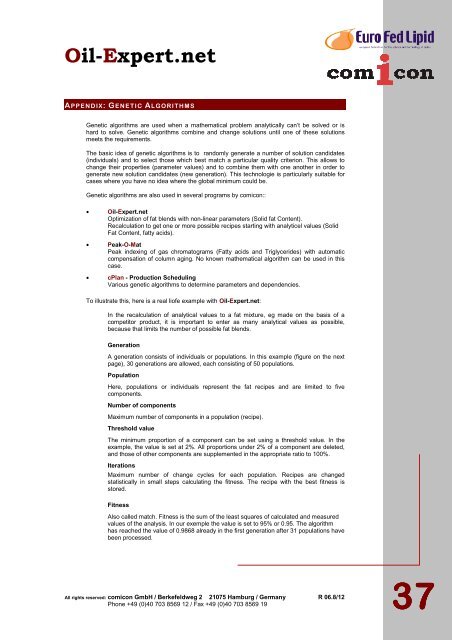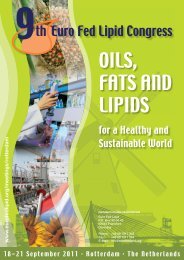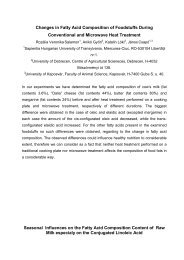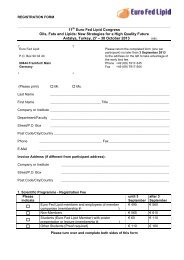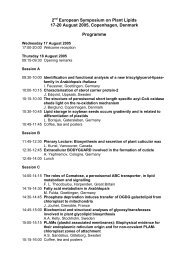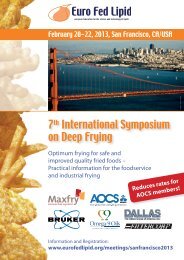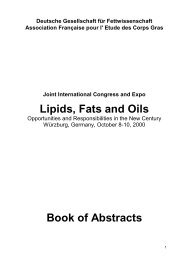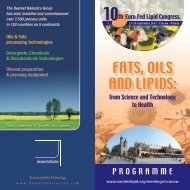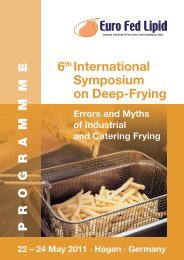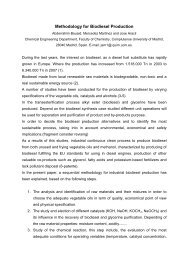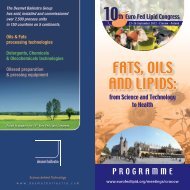Oil-Expert.net - Euro Fed Lipid
Oil-Expert.net - Euro Fed Lipid
Oil-Expert.net - Euro Fed Lipid
Create successful ePaper yourself
Turn your PDF publications into a flip-book with our unique Google optimized e-Paper software.
<strong>Oil</strong>-<strong>Expert</strong>.<strong>net</strong><br />
APPENDIX: GENETIC ALGORITHMS<br />
Ge<strong>net</strong>ic algorithms are used when a mathematical problem analytically can’t be solved or is<br />
hard to solve. Ge<strong>net</strong>ic algorithms combine and change solutions until one of these solutions<br />
meets the requirements.<br />
The basic idea of ge<strong>net</strong>ic algorithms is to randomly generate a number of solution candidates<br />
(individuals) and to select those which best match a particular quality criterion. This allows to<br />
change their properties (parameter values) and to combine them with one another in order to<br />
generate new solution candidates (new generation). This technologie is particularly suitable for<br />
cases where you have no idea where the global minimum could be.<br />
Ge<strong>net</strong>ic algorithms are also used in several programs by comicon::<br />
• <strong>Oil</strong>-<strong>Expert</strong>.<strong>net</strong><br />
Optimization of fat blends with non-linear parameters (Solid fat Content).<br />
Recalculation to get one or more possible recipes starting with analyticel values (Solid<br />
Fat Content, fatty acids).<br />
• Peak-O-Mat<br />
Peak indexing of gas chromatograms (Fatty acids and Triglycerides) with automatic<br />
compensation of column aging. No known mathematical algorithm can be used in this<br />
case.<br />
• cPlan - Production Scheduling<br />
Various ge<strong>net</strong>ic algorithms to determine parameters and dependencies.<br />
To illustrate this, here is a real liofe example with <strong>Oil</strong>-<strong>Expert</strong>.<strong>net</strong>:<br />
In the recalculation of analytical values to a fat mixture, eg made on the basis of a<br />
competitor product, it is important to enter as many analytical values as possible,<br />
because that limits the number of possible fat blends.<br />
Generation<br />
A generation consists of individuals or populations. In this example (figure on the next<br />
page), 30 generations are allowed, each consisting of 50 populations.<br />
Population<br />
Here, populations or individuals represent the fat recipes and are limited to five<br />
components.<br />
Number of components<br />
Maximum number of components in a population (recipe).<br />
Threshold value<br />
The minimum proportion of a component can be set using a threshold value. In the<br />
example, the value is set at 2%. All proportions under 2% of a component are deleted,<br />
and those of other components are supplemented in the appropriate ratio to 100%.<br />
Iterations<br />
Maximum number of change cycles for each population. Recipes are changed<br />
statistically in small steps calculating the fitness. The recipe with the best fitness is<br />
stored.<br />
Fitness<br />
Also called match. Fitness is the sum of the least squares of calculated and measured<br />
values of the analysis. In our exemple the value is set to 95% or 0.95. The algorithm<br />
has reached the value of 0.9868 already in the first generation after 31 populations have<br />
been processed.<br />
37<br />
37<br />
All rights reserved: comicon GmbH / Berkefeldweg 2 21075 Hamburg / Germany R 06.8/12<br />
Phone +49 (0)40 703 8569 12 / Fax +49 (0)40 703 8569 19


